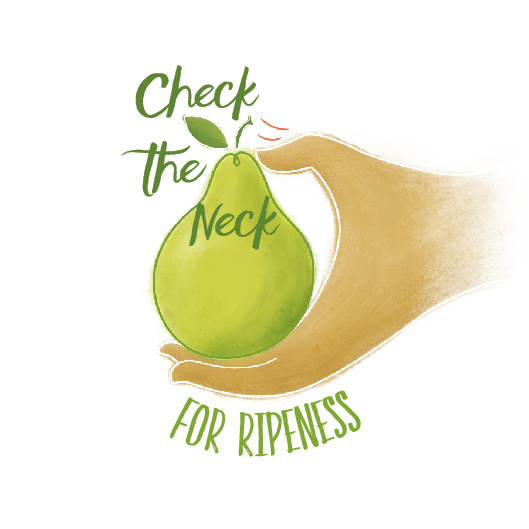A Ripe Pear is a Sweet Pear
 A little known fact about the pear is that it is one of the few fruits that does not ripen on the tree. The pear is harvested when it is mature, but not yet ripe, and, if left at room temperature, it slowly reaches a sweet and succulent maturity as it ripens from the inside out.
A little known fact about the pear is that it is one of the few fruits that does not ripen on the tree. The pear is harvested when it is mature, but not yet ripe, and, if left at room temperature, it slowly reaches a sweet and succulent maturity as it ripens from the inside out.
As tempting as the pear might be right from the grocer’s stand, a little bit of patience and know-how will ensure the pear reaches its peak flavor.
So, how do you know when the pear has ripened to sweet and juicy perfection?
While a Bartlett’s skin color brightens as it ripens, most varieties of pears show little change in color.
The best way to judge ripeness for non-Bartlett varieties is to Check the Neck™: Apply gentle pressure to the neck of the pear with your thumb. If it yields to pressure, it’s ripe. Easy, isn’t it?
Here’s what you need to do to ripen your pears:
- Leave firm, unripe pears at room temperature so that they can ripen.
- Check the Neck for Ripeness daily, by applying gentle pressure to the neck, or stem end, of the pear with your thumb. If it yields to pressure, then it’s ripe and ready to eat!
- Once the pear is ripe, it can be refrigerated to slow the ripening process and saved for use up to five days later.
To Prevent Browning
Keep a fresh fruit fresh.
Like many fruits, the flesh of cut or peeled pears will eventually brown. This natural oxidation process won’t affect the taste or quality. However, to keep your pears looking appetizing and to prevent browning, dip them in a mild solution of 50% water and 50% lemon juice!
Refrigerating Pears
Remember, don’t refrigerate an unripe pear!
Ripened pears can be used at once or put under refrigeration (35º to 45º F) until you want to use them. Refrigeration will delay further ripening but will not stop it altogether, giving you adequate time to include fresh pears in your menu planning. Remember, pears need to ripen at room temperature, so don’t refrigerate an unripe pear!
Speedy Ripening
Flavor well worth the wait
Place underripe pears in a fruit bowl at room temperature near other ripening fruit like bananas, which naturally give off ethylene and will help speed up the ripening process. And if you find yourself with a few too many overripe pears, blend them into smoothies, soups, sauces and purees!
Wash Before Eating
All it takes is cold water
Thoroughly wash pears immediately prior to eating or preparation. Under cold, drinkable water, use your clean hands or a soft-bristled produce scrub brush to gently but vigorously scrub the entire exterior of the pear, taking extra care to cleanse the indentations near the stem (at the top) and calyx (at the bottom) of the pear. The total process will take 15 – 20 seconds.
Washing the entire exterior of the pear will help to eliminate dirt and/or commonly occurring bacteria that may be found on the fruit’s surface. Wash fruit even if you plan on peeling it.
Learn more about proper food handling and the food safety procedures you need to practice at home at www.befoodsafe.org.